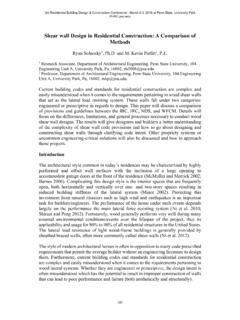Transcription of Figure 2: A cost comparison of engineered wood ... - Civil
1 38 Structural Engineering & Design April 2010 to the desired depth. High strengths are achieved in a similar way as SCL by selecting high-quality mate-rial and dispersing defects throughout the members. Additional strength is achieved by placing the highest-quality laminations in specific zones within the members. Glulams can be manufac-tured as unbalanced bending members with designated compression and ten-sion zones to achieve higher efficiency. The members are also manufactured with a designated top and bottom for simple span beam applications. Glu-lams are most often selected for their visual appeal where the structural wood framing will remain wood I-Joists are effi-ciently shaped members similar to W shapes in structural steel.
2 They are formed by gluing either sawn lumber or LVL flanges to a plywood or oriented strandboard web. The composite nature takes advantage of the high strength of quality sawn lumber or LVLs in con-junction with the high shear strength of plywood. The I shape also results in a lightweight member for ease in con-structability. Most wood I-beams are made with knockouts or precut hole locations to simplify the installation of mechanical and electrical system pipe/conduit. These members are useful for beam and girder applications where the higher strength of SCL is not needed, but sawn lumber is not efficient. Since wood I-beams are slender, more care has to be taken during erection to maintain stability.
3 When designing with SCL it is important to consider environmental conditions that may be encountered both during construction and in service. When SCL gets wet during construc-tion and then dries under load, the long-term dead load deflection can be more than anticipated from standard calculations. We have encountered several instances where SCL members, even when continuously dry, have more than twice the calculated long-term dead load deflection. In addition, wood I-joist floor systems can experience undesirable vibration characteristics even when designed for code-stipulated deflection limits. Some manufacturers recommend increased stiffness and deflection limits to reduce floor vibrations.
4 ComparisonNatural and engineered wood prod-ucts are available in a variety of grades, sizes, and geometries that offer the designer many options for framing. Figure 1 summarizes strength and size limitations of wood products, as well as uses for each type of 2 includes a comparison of engineered wood systems in typical floor framing applications. The design assumes a spacing of 16-inches on-cen-ter, repetitive members, floor dead loads of 15 pounds per square foot (psf ), floor live loads of 40 psf, and deflection cri-teria of L/360 for total load and L/480 for live load. Relative costs (based in the Northeastern United States) are for comparison . It is clear that for shorter spans, dimension lumber will be the most efficient system.
5 Wood I-joists may be a viable option if issues with dimension lumber submittals, as previously men-tioned, are an anticipated problem or if greater consistency between members is desired. For moderate spans, wood I-beams are both cost effective and comparable in depth to the dimension lumber systems. At long spans, wood-I joists are still cost effective, but other SCL options become reasonable. Due to the uniqueness of natural building materials, the architect and engineer need to be aware of the ben-efits and limitations of each option. Consideration must be made not only to the final constructed building, but also to the methods of construction that may affect both the strength and stiffness of various wood products.
6 Matthew Johnson, , is an asso-ciate principal, and Ariane Fund is a staff II engineer. Both are with Simpson Gumpertz & Heger Inc. ( ), in Waltham, Mass., and can be reached at and respectively. WOODF igure 2: A cost comparison of engineered wood systems in typical floor framing applications Span Type Size Approximate $/ft 10 feet Dimension Lumber (1) 2x8 Wood-i (1) TJi 9-1/2 LVL (1) 1-3/4 x 7-1/4 Parallam (1) 3-1/2 x 9-1/2 glulam (Arch. Grade) (1) 3-1/2 x 7-1/4 20 feet Dimension Lumber (3) 2x10 Wood-i (1) TJi 11-7/8 LVL (1) 1-3/4 x 11-7/8 Parallam (1) 3-1/2 x 9-1/2 glulam (Arch. Grade) (1) 3-1/2 x 9-1/4 30 feet Dimension Lumber (6) 2x12 Wood-i (1) TJi 18 LVL (1)1-3/4 x18 Parallam (1) 3-1/4 14 glulam (Arch.)
7 Grade) (1) 3-1/2 x 14
